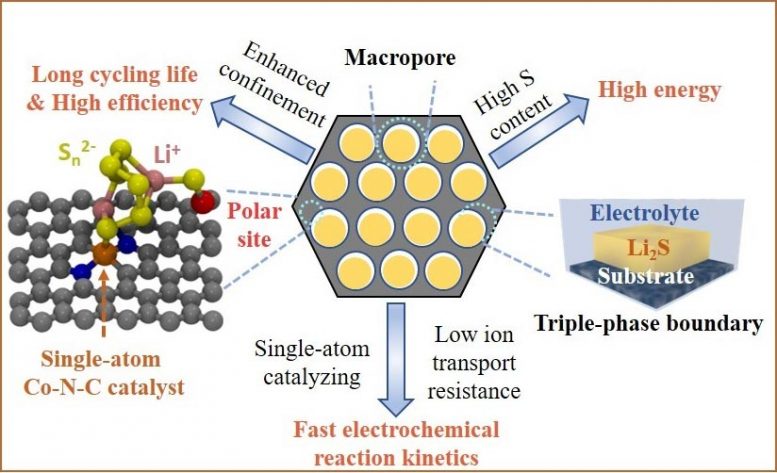
An all-in-one solution for the design strategy of macroporous host with double-end binding sites. Credit: HKUST
A team led by Cheong Ying Chan Professor of Engineering and Environment Prof. ZHAO Tianshou, Chair Professor of Mechanical and Aerospace Engineering and Director of HKUST Energy Institute, has proposed a novel cathode design concept for lithium–sulfur (Li–S) battery that substantially improves the performance of this kind of promising next-generation battery.
Li–S batteries are regarded as attractive alternatives to lithium-ion (Li-ion) batteries that are commonly used in smartphones, electric vehicles, and drones. They are known for their high energy density while their major component, sulfur, is abundant, light, cheap, and environmentally benign.
Li–S batteries can potentially offer an energy density of over 500 Wh/kg, significantly better than Li-ion batteries that reach their limit at 300 Wh/kg. The higher energy density means that the approximate 400km driving range of an electric vehicle powered by Li-ion batteries can be substantially extended to 600-800km if powered by Li–S batteries.
While exciting results on Li–S batteries have been achieved by researchers worldwide, there is still a big gap between lab research and commercialization of the technology on an industrial scale. One key issue is the polysulfide shuttle effect of Li-S batteries that causes progressive leakage of active material from the cathode and lithium corrosion, resulting in a short life cycle for the battery. Other challenges include reducing the amount of electrolyte in the battery while maintaining stable battery performance.
To address these issues, Prof. Zhao’s team collaborated with international researchers to propose a cathode design concept that could achieve good Li–S battery performance.
The highly oriented macroporous host can uniformly accommodate the sulfur while abundant active sites are embedded inside the host to tightly absorb the polysulfide, eliminating the shuttle effect and lithium metal corrosion. By bringing up a design principle for sulfur cathode in Li–S batteries, the joint team increased the batteries’ energy density and made a big step towards the industrialization of the batteries.
“We are still in the middle of basic research in this field,” Prof. Zhao said. “However, our novel electrode design concept and the associated breakthrough in performance represent a big step towards the practical use of a next-generation battery that is even more powerful and longer-lasting than today’s lithium-ion batteries.”
Their research work was recently published in Nature Nanotechnology.
Reference: “A high-energy and long-cycling lithium–sulfur pouch cell via a macroporous catalytic cathode with double-end binding sites” by Chen Zhao, Gui-Liang Xu, Zhou Yu, Leicheng Zhang, Inhui Hwang, Yu-Xue Mo, Yuxun Ren, Lei Cheng, Cheng-Jun Sun, Yang Ren, Xiaobing Zuo, Jun-Tao Li, Shi-Gang Sun, Khalil Amine and Tianshou Zhao, 3 December 2020, Nature Nanotechnology.DOI: 10.1038/s41565-020-00829-5
Team members from HKUST include Prof. Zhao and his current PhD students ZHAO Chen, ZHANG Leicheng, and former PhD student REN Yuxun (2019 graduate). Other collaborators include researchers from Argonne National Laboratory and Stanford University in the US, Xiamen University in Mainland China, and Imam Abdulrahman Bin Faisal University in Saudi Arabia.